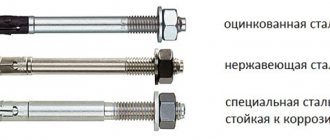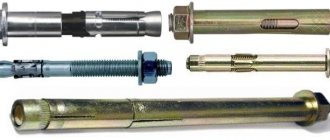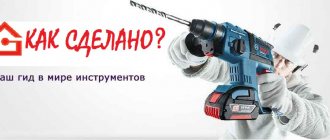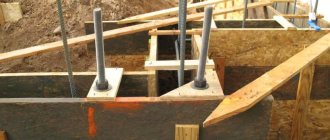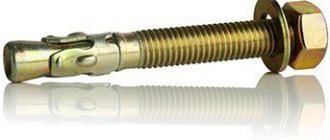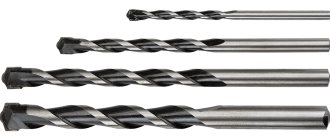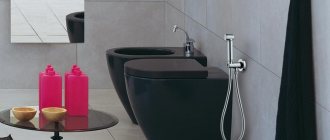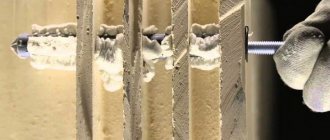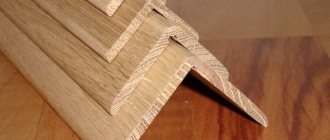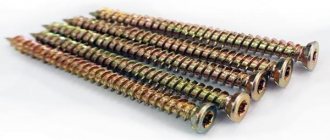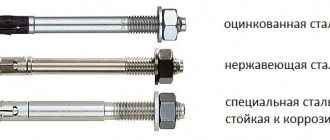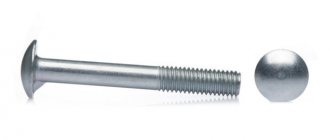Anchor sizes for concrete
Often on the display case you can see the marking of this fastener only by the diameter of the thread and the length of the rod (stud). For example: M20×220. This data is not enough: the “secret” remains the diameter of the drill, the depth of the hole and a number of other information necessary for installation.
You can also find the following marking: M10 12x100. Here the diameter of the hole, i.e. drill (12 mm), is added. But this is not complete information either.
The full marking of the anchors looks, for example, like this: M6 8/40×90, where M6 is the thread diameter, 8 is the drill, 90 is the minimum hole depth, 40 is the maximum thickness of the attached material. Based on this marking, you can already choose an anchor for concrete.
Working principle and application
Concrete is a porous material with a heterogeneous structure. And in the places of fastening, various forces appear - twisting, bending, shearing, shearing, compression, tearing. The concrete anchor takes over them, distributing them together with the supporting structure.
Basic principles of operation of concrete anchors:
Anchors for concrete can be of different designs, types, sizes. They are made from special steel according to GOST and coated with a layer of anti-corrosion agent. The rod can be 6-20 millimeters in diameter and up to 220 millimeters long.
Kawabanga! What is an anti-frost additive to concrete
Any anchor includes the following parts:
- The bolt itself
- Cone with a layer of thread inside
- Bushing with special cutouts
Structural fasteners are used to counteract the displacement of parts of the assembly if their stability is guaranteed by their own weight; anchors are also relevant when straightening in construction.
Anchors for concrete - parameters of fastening bolts
Concrete anchors come in different sizes and types. They are made in accordance with GOST from special high-strength steel, and the surface of the part is coated with a special anti-corrosion compound. The diameter of the rod reaches 6-20 mm, and its length reaches 220 mm.
The anchor itself consists of three parts:
- bushing with special cutouts;
- cone with internal thread;
- bolt.
The size of the anchor has three meanings, for example, marking an anchor with the size “M8/10X30”:
- “M8” – thread size;
- “10” – outer diameter of the anchor (a hole of this diameter must be drilled before installation);
- “30” is the length of the anchor.
Concrete anchors can provide reliable fastening of any structure
Main characteristics of anchors
The anchor is a steel rod, ranging in size from 45 mm to 200 mm. A characteristic design feature is provided by a sleeve with longitudinal slots and a nut.
In the product name, the first number indicates the diameter of the suitable hole, the second – the length of the fastener itself, and the third – the thread size.
Types of anchors by installation method
Ampoule - is a glass capsule with a two-component mixture and is intended for one-time use. Requires mixing directly in the hole.
Cartridge - the adhesive composition is located in a cylinder and is mixed immediately upon feeding. A special gun is required to insert into the hole.
Some manufacturers produce tubes with a measuring scale, which greatly simplifies the feeding process and eliminates the need for additional tools during installation.
An adjustable anchor is installed under the posts and is able to adjust the horizontal surface relative to the vertical.
Kawabanga! Which adhesive is best for concrete
Features of installation of anchors for concrete
The reliability of fastening obtained using an anchor bolt is influenced by a number of factors:
Sequence of installation operations (click to enlarge)
Installation of anchor-type bolts can be carried out in various structures, the material of which must be of sufficiently high strength. These include, in particular:
- concrete foundations;
- walls and partitions made of concrete and brick;
- floor slabs, which are usually made of concrete.
Mechanical anchor installation diagrams
Objects and structural elements that are fastened with such bolts are usually:
Load calculation depending on anchor parameters
As mentioned above, fixing an anchor-type bolt inside a pre-prepared hole can be achieved in two main ways:
- by wedging the spacer sleeve inside the hole;
- due to a special adhesive composition that binds the bolt and the inner walls of the hole (chemical anchor).
There are requirements for holes in the fastened part, which should not exceed the values specified in the table. Large gaps can be filled with mortar
Characteristics
The main element of the anchor product is the pin. A nut is screwed onto the threaded part of the stud. Another important element is the bushing, the inner surface of which is equipped with slots similar to petals. In order for the fastening element to firmly hold the structure mounted on the wall, in addition to using high-quality anchors and dowels, it is important to take into account the following factors:
- How high-quality is the material to which the products are attached?
- Types and sizes of fastening elements, each of which is selected taking into account operational features and load.
- The correct choice of location for the fastening device.
- Compliance with technological rules for installing fastening bolts.
- Strength characteristics of the product itself.
This type of fastener is often used when you need to fix some metal element to the wall.
Anchor type bolts are used to secure wood, metal and other structural objects to surfaces made of durable concrete. These include:
- concrete floor and base;
- walls, partitions;
- concrete ceiling made of reinforced concrete slabs.
These bolts are used to fasten metal beams to the wall. In addition, fasteners allow you to securely fasten floor joists or ceilings. Without a concrete dowel, it will not be possible to efficiently install a lamp or chandelier to the ceiling. It is also used to fasten timber to concrete. Dowels securely fasten metal pipes and other elements of stair structures to the concrete base. Special purpose fasteners allow you to fix railway rails to concrete jumpers installed on the ground.
For brick, as well as for cellular concrete, a different set of fasteners is used, which differs in design and installation method.
Chemical Anchor Bolts for Concrete
The battery-powered dispenser allows you to introduce the adhesive composition quickly and accurately
Procedure for installing a chemical anchor
Thus, for different types of concrete, different types of anchors are provided, the selection of which should be given special attention.
Chemical anchor
It simplifies installation work and is resistant to corrosion. Thanks to the resin that is included in its composition, during hardening, a chemical anchor allows you to add strength to the concrete wall at the attachment point. Therefore, they can be used for porous blocks.
Thus, the use of a concrete anchor increases the strength of fastening materials. They are used in everyday life and in construction.
The chemical anchor bolt is strong in fastening porous and hollow materials, including gas block and foam block.
Types of mechanical anchor connections for concrete
For fastening to a structure made of ordinary dense concrete, a mechanical anchor is most often chosen. The reasons for this are:
In accordance with the listed advantages, all that remains is to choose an anchor for concrete among the manufactured modifications listed below.
Drive-in anchors
During installation, the sleeve is placed in the hole, then pushed deep into it using a special striker. At the same time, the bushing is unclenched, due to which it is secured. Then we simply screw the threaded part into the bushing.
Expansion (expansion) anchors
There is a modification of expansion anchors: double-expansion - with two wedging zones of the expansion sleeve or with two expansion sleeves. This design provides a more secure fastening.
Kawabanga! Sand-gravel concrete (SGMC)
Wedge anchors
Wedge anchors are most often used for highly loaded connections.
Another modification of wedge anchors is rod anchors. Its main difference is the increased length of the hairpin. Its purpose is to fasten structures of large thickness.
Mechanical types
Expansion anchor
The fixing ability of these elements is ensured by the presence of a special wedge.
It is used for fastening objects with an impressive mass to a concrete base, for example, poles, gate posts made of metal or corrugated sheets, large industrial installations, etc. These construction and fastening elements are equipped with a special wedge that ensures reliable fastening. A frame anchor is used to securely secure window or door frames to a concrete base. This is a long fastening element equipped with two wedging zones, thanks to which it firmly holds the structure. For sandwich panels, it is recommended to use a spacer dowel made of high quality nylon.
Metal, polymer or nylon drive
With the help of such fasteners, joists, wooden blocks, metal channels and other structural elements can be quickly installed to a concrete surface. First, the concrete floor or slab must be drilled, then the anchor is driven into the resulting hole with a hammer. Afterwards, what needed to be installed is installed in this place. With the help of studs, which are fixed with nuts, final fixation is carried out. Experts do not recommend using driven fasteners for old porous concrete, as well as for lightweight concrete, for example, gas and foam blocks.
PFG fasteners
It is advisable to use such elements when the surface to which something will be fixed is not of high quality.
Used to work with structures made of low quality concrete. In addition, such fasteners are suitable for fixing elements, such as profiles, on ceilings and walls in dilapidated buildings. Hardware differs from the rest in its larger expansion area. There are PFG dowels that are used to secure cables and ropes to the surface. These types of fasteners are equipped with a special ring, which is often used for installing chandeliers and lamps. Anchor PFG elements, which look like the letter “G”, are mainly used for installation on the wall surface of water heaters.
Concrete dowel
These are special nails used to fasten necessary objects in difficult areas - at the edges of a concrete vertical surface. The dowel does not require additional fixation, because the fasteners are screwed directly into a pre-drilled hole. To make the fastening more durable, it is recommended to pour a little epoxy glue into the hole before screwing in the dowel.
Wedge fasteners
The strength of the element's fixation is ensured by a wedge, which becomes wider as it is driven in.
This type of bolts is used to fix heavy elements to concrete, for example, a metal post, a concrete pillar reinforced with reinforcement, or scaffolding. Before installing the wedge dowel, a hole is pre-drilled, and the fasteners are fastened without a jacket. During screwing, the wedge located in the center of the bushing gradually expands. Once the dowel is driven in, it is important to remember to tightly tighten the nut that secures the bolt after the plug has expanded.
Dowel for fastening wires and corrugations
Fastening the cable or corrugation is carried out with special clip-bolts shaped like a clamp, and the clamp itself comes in 2 varieties - for flat and round cables, for example, such as KLD and RG 6. First, a hole is drilled in the concrete, then the cable is inserted into the clamp, then the dowel is pushed into the hole. The sides of the clip are equipped with special notches that securely hold the fastener.
The clamp along with the cable is fixed in a ready-made hole in the wall.
